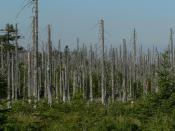Acid Rain is a leading cause to deforestation and other harmful effects to the environment. Acid Rain is produced when coal, oil and gas are burned; they generate sulfur dioxide, nitric oxide and nitrous dioxide that rise into the atmosphere. The oxides then go through chemical reactions and the end result is acid rain or simply a lower pH level then normal or naturally. The lowest recorded pH level in the base of clouds in the northeast is 2.6 and the rain that falls usually has pH levels ranging in the fours. The acid cloud may produce rain, snow or another type of weather condition. At pH levels in the fours, threes or even lower, the acid can cause substantial damage to plant life and future growth. On the surface the effects may not be too evident but acid rain can do serious damage that is only noticeable in long run.
Acid rain, acid fog, acid snow or any other form, can create an immediate impact and prolonged damaging to the plant life. The different levels of pH, type of acid, and the previous exposure of the plant life determines the effects of the rain. Effects of acid rain are numerous and include: deterioration of the surfaces on the plants leaves, impairing of the plants ability to with stand extreme temperatures, and the plants ability to germinate. Any of the effects can prove to be fatal for the individual plant and the future of the ecosystem.
Consistent exposure to acid rain causes the soil to lose nutrients, which are essential to maintaining the health of the ecosystem. The lack of nutrients causes the plants to grow more slowly and reproduce slower or not grow at all. If acid rain wipes out the plant life, the animal life goes...


